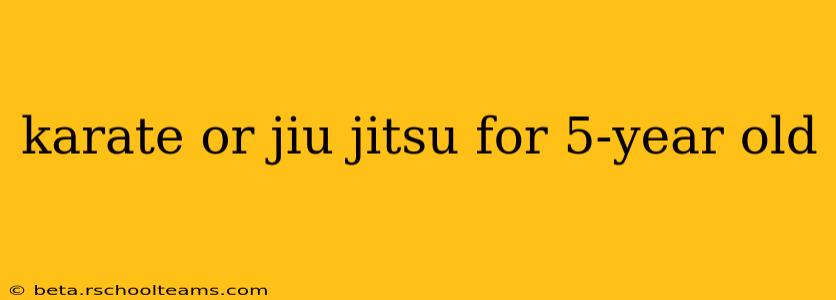Choosing the right martial art for your 5-year-old can feel overwhelming. Karate and Jiu-Jitsu are both popular choices, each offering unique benefits. This guide will help you weigh the pros and cons of each, addressing common parent concerns and ultimately guiding you towards the best fit for your child.
What are the Key Differences Between Karate and Jiu-Jitsu?
Karate and Jiu-Jitsu differ significantly in their approaches to combat. Karate emphasizes striking techniques like punches, kicks, and blocks, often incorporating katas (prearranged forms) and sparring. Jiu-Jitsu, on the other hand, focuses on grappling, takedowns, joint locks, and submissions. While both arts teach self-defense, their methodologies are fundamentally distinct.
Is Karate Good for 5-Year-Olds?
Karate can be an excellent choice for a 5-year-old. The structured environment fosters discipline, improves focus, and builds confidence. The emphasis on physical activity promotes fitness and coordination. Many karate programs for young children incorporate games and fun activities to keep them engaged. However, the intensity of some sparring aspects might need careful consideration depending on the dojo and your child's temperament.
What are the Benefits of Karate for 5-Year-Olds?
- Improved discipline and focus: Karate training demands concentration and adherence to instructions.
- Increased physical fitness: It enhances strength, flexibility, and cardiovascular health.
- Boosted self-confidence: Mastering techniques and achieving belt ranks builds self-esteem.
- Enhanced coordination and balance: The precise movements required improve motor skills.
- Self-defense skills: While not the primary focus at this age, basic self-defense techniques are introduced.
Is Jiu-Jitsu Good for 5-Year-Olds?
Jiu-Jitsu, particularly its gentler forms adapted for children, can also be a positive experience. It teaches children about leverage, body positioning, and control, skills that extend beyond the mat. The emphasis on ground fighting might be less appealing to some children but can build strength and resilience. It's crucial to find a program specifically designed for young children, prioritizing safety and age-appropriate techniques.
What are the Benefits of Jiu-Jitsu for 5-Year-Olds?
- Improved strength and flexibility: Grappling requires significant physical effort.
- Development of problem-solving skills: Jiu-Jitsu involves strategizing and finding solutions on the mat.
- Enhanced self-control and emotional regulation: Learning to control one's body and reactions is crucial.
- Increased body awareness: Children develop a better understanding of their physical capabilities.
- Development of respect and sportsmanship: Most Jiu-Jitsu programs emphasize good etiquette and respect for training partners.
Which Martial Art is Better for Self-Defense for a 5-Year-Old?
At age 5, the primary focus should not be on self-defense in the traditional sense. Instead, both karate and Jiu-Jitsu instill valuable life skills like discipline, respect, and self-confidence, which are crucial building blocks for self-defense later in life. The specific techniques learned are less important at this age than the development of character and physical well-being.
How Do I Choose Between Karate and Jiu-Jitsu for My 5-Year-Old?
The best martial art for your 5-year-old depends on their personality and your priorities.
- Consider your child's temperament: Is your child more energetic and outgoing (suited to karate), or more thoughtful and strategic (suited to Jiu-Jitsu)?
- Visit different dojos/gyms: Observe classes, speak to instructors, and gauge the overall atmosphere. A positive and supportive environment is crucial.
- Prioritize safety: Ensure the instructors are experienced in working with young children and that safety protocols are in place.
- Look for age-appropriate programs: The curriculum should be specifically designed for the developmental stage of 5-year-olds.
Ultimately, the best way to decide is to try both! Many schools offer introductory classes or trial periods, allowing your child to experience each martial art before making a commitment. Observe their engagement and enthusiasm – their enjoyment will be the best indicator of the right fit.
